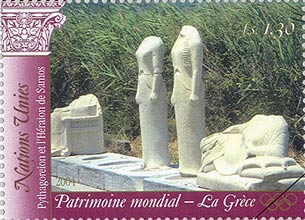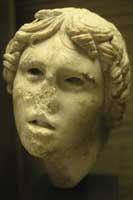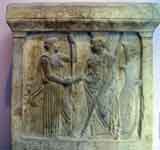.
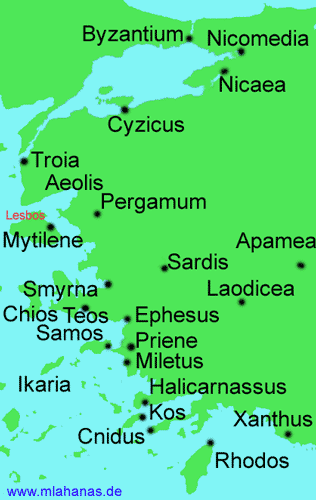
Samos (Greek Σαμος) is an island in southeastern Greece in the Aegean Sea, near the coast of Turkey. It is located between the island of Chios to the North and the Dodecanese Islands to the South. Its capital today and main port is the city of Vathí, also called Samos; other ports are Karlóvassi and Pythagóreion, formerly called Tigáni.

Samos from Space
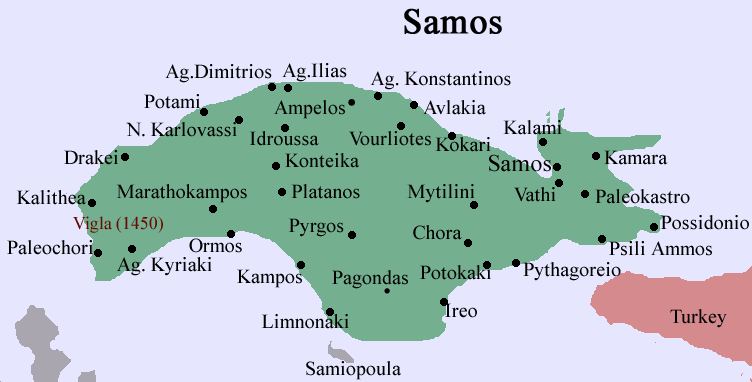
In classical times the island was a center of Ionian culture and luxury, known for its wines and its red pottery (called Samian ware by the Romans). Its most famous building, for a brief time, was the archaic Ionic Temple of Hera (Heraion), built by the architects Rhoikos and Theodoros c. 540 BC, which stood opposite the cult altar of Hera in her sanctuary. It was a dipteral temple, that is with a portico of columns two deep, which surrounded it entirely (a peripteral temple). It had a deep square roofed pronaos in front of a closed cella. Cella and pronaos were divided into three equal aisles by two rows of columns that marched down the pronaos and through the temple. The result was that Hera was worshipped in a temple fitted within a stylized grove of columns, eight across and 21 deep. The columns stood on unusual bases that were horizontally fluted.
|
World Heritage sites : The Heraion of Samos, sculptures at the Sacred way leading to the monumental Hera Temple. |
Heraion Samos, Statue of Hera, "Kore" dedicated by Cheramyes, "Cheramyes dedicated me to Hera, as a gift" Samos. c. 560 BC , |
The Heraion of Samos was the first of the gigantic Ionic temples. Unfortunately it stood for only about a decade before it was destroyed, probably by an earthquake. One of the giant statues from the Heraion survives in the Samos Archaeological Museum.
Pythagorio, on the south-eastern coast of Samos
In the 6th century BC Samos was ruled by the famous tyrant Polycrates.
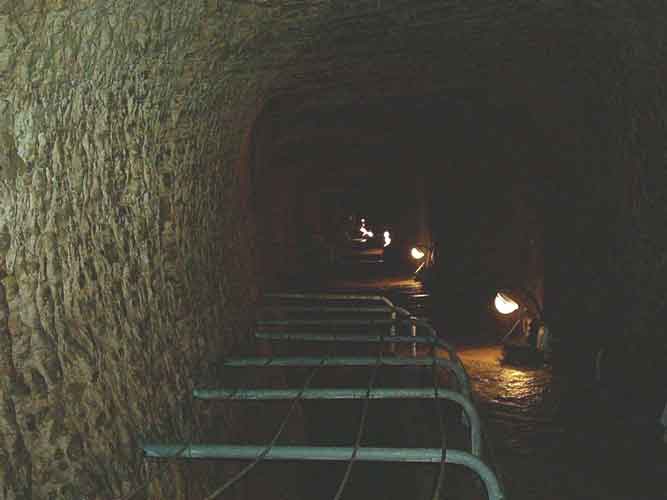
Eupalinos tunnel in Pythagorio, Samos. Copyright Ch. Eckert 2003.
During his reign, two working groups under the lead of the engineer Eupalinos dug a tunnel through Mount Kastro to build an aqueduct for supplying Tigáni (the capital of Samos) with water, which was of utmost stragetic importance. It is not documented, which method Eupalinos employed to make the two groups meet in the middle of the mountain. With a length of 1036 meters, the tunnel today is known as one of the masterpieces of ancient engineering.
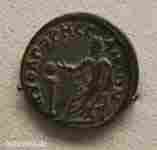
Even so the island followed the fate of the Ionian cities, being subjugated to the Persian empire. During the Peloponnesian War (431-–404 BC), Samos took the side of Athens against Sparta, providing their port to the Athenian fleet.
Perhaps the most famous persons ever connected with classical Samos were Pythagoras and a slave who belonged to Iadmon, whose name was Aesop (famous for Aesop's Fables). In 1955 the town of Tigáni was renamed Pythagório to honour the famous mathematician. Other notable personalities include the philosopher Epicurus, who was born on the island. The astronomer Aristarchus, whom history credits with the first recorded heliocentric model of the solar system, lived on Samos. As did the great sculptor and inventor Theodorus. Herodotus (known for his book The Histories ) lived in Samos for a time.
| Ancient Greece
Science, Technology , Medicine , Warfare, , Biographies , Life , Cities/Places/Maps , Arts , Literature , Philosophy ,Olympics, Mythology , History , Images Medieval Greece / Byzantine Empire Science, Technology, Arts, , Warfare , Literature, Biographies, Icons, History Modern Greece Cities, Islands, Regions, Fauna/Flora ,Biographies , History , Warfare, Science/Technology, Literature, Music , Arts , Film/Actors , Sport , Fashion --- |
Retrieved from "http://en.wikipedia.org/"
All text is available under the terms of the GNU Free Documentation License


